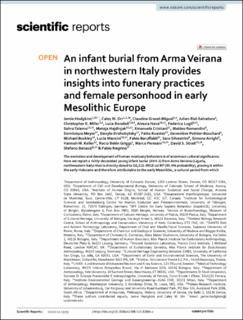| dc.contributor.author | Hodgkins, Jamie | |
| dc.contributor.author | Orr, Caley M. | |
| dc.contributor.author | Gravel-Miguel, Claudine | |
| dc.contributor.author | Riel-Salvatore, Julien | |
| dc.contributor.author | Miller, Christopher | |
| dc.contributor.author | Bondioli, Luca | |
| dc.contributor.author | Nava, Alessia | |
| dc.contributor.author | Lugli, Federico | |
| dc.contributor.author | Talamo, Sahra | |
| dc.contributor.author | Hajdinjak, Mateja | |
| dc.contributor.author | Cristiani, Emanuela | |
| dc.contributor.author | Romandini, Matteo | |
| dc.contributor.author | Meyer, Dominique | |
| dc.contributor.author | Drohobytsky, Danylo | |
| dc.contributor.author | Kuester, Falko | |
| dc.contributor.author | Pothier-Bouchard, Geneviève | |
| dc.contributor.author | Buckley, Mike | |
| dc.contributor.author | Mancini, Lucia | |
| dc.contributor.author | Baruffaldi, Fabio | |
| dc.contributor.author | Silvestrini, Sara | |
| dc.contributor.author | Arrighi, Simona | |
| dc.contributor.author | Keller, Hannah M. | |
| dc.contributor.author | Griggs, Rocío Belén | |
| dc.contributor.author | Peresani, Marco | |
| dc.contributor.author | Strait, David S. | |
| dc.contributor.author | Benazzi, Stefano | |
| dc.contributor.author | Negrino, Fabio | |
| dc.date.accessioned | 2022-03-08T12:11:40Z | |
| dc.date.available | 2022-03-08T12:11:40Z | |
| dc.date.created | 2022-02-07T10:35:32Z | |
| dc.date.issued | 2021 | |
| dc.identifier.issn | 2045-2322 | |
| dc.identifier.uri | https://hdl.handle.net/11250/2983777 | |
| dc.description.abstract | The evolution and development of human mortuary behaviors is of enormous cultural significance. Here we report a richly-decorated young infant burial (AVH-1) from Arma Veirana (Liguria, northwestern Italy) that is directly dated to 10,211–9910 cal BP (95.4% probability), placing it within the early Holocene and therefore attributable to the early Mesolithic, a cultural period from which well-documented burials are exceedingly rare. Virtual dental histology, proteomics, and aDNA indicate that the infant was a 40–50 days old female. Associated artifacts indicate significant material and emotional investment in the child’s interment. The detailed biological profile of AVH-1 establishes the child as the earliest European near-neonate documented to be female. The Arma Veirana burial thus provides insight into sex/gender-based social status, funerary treatment, and the attribution of personhood to the youngest individuals among prehistoric hunter-gatherer groups and adds substantially to the scant data on mortuary practices from an important period in prehistory shortly following the end of the last Ice Age. | en_US |
| dc.language.iso | eng | en_US |
| dc.publisher | Nature Research | en_US |
| dc.rights | Navngivelse 4.0 Internasjonal | * |
| dc.rights.uri | http://creativecommons.org/licenses/by/4.0/deed.no | * |
| dc.title | An infant burial from Arma Veirana in northwestern Italy provides insights into funerary practices and female personhood in early Mesolithic Europe | en_US |
| dc.type | Journal article | en_US |
| dc.type | Peer reviewed | en_US |
| dc.description.version | publishedVersion | en_US |
| dc.rights.holder | Copyright The Author(s) 2021 | en_US |
| dc.source.articlenumber | 23735 | en_US |
| cristin.ispublished | true | |
| cristin.fulltext | original | |
| cristin.qualitycode | 1 | |
| dc.identifier.doi | 10.1038/s41598-021-02804-z | |
| dc.identifier.cristin | 1998435 | |
| dc.source.journal | Scientific Reports | en_US |
| dc.identifier.citation | Scientific Reports. 2021, 11, 23735. | en_US |
| dc.source.volume | 11 | en_US |

